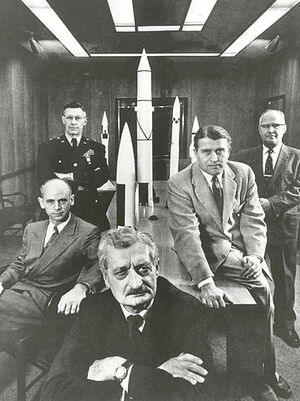Operation Paperclip (nonfiction): Difference between revisions
No edit summary |
No edit summary |
||
| Line 3: | Line 3: | ||
The primary purpose for Operation Paperclip was U.S. military advantage in the Soviet–American Cold War, and the Space Race. The Soviet Union was more aggressive in forcibly recruiting more than 2,200 German specialists—a total of more than 6,000 people including family members—with Operation Osoaviakhim during one night on October 22, 1946. | The primary purpose for Operation Paperclip was U.S. military advantage in the Soviet–American Cold War, and the Space Race. The Soviet Union was more aggressive in forcibly recruiting more than 2,200 German specialists—a total of more than 6,000 people including family members—with Operation Osoaviakhim during one night on October 22, 1946. | ||
The Joint Chiefs of Staff (JCS) established the first secret recruitment program, called Operation Overcast, on July 20, 1945, initially "to assist in shortening the Japanese war and to aid our postwar military research".[4] The term "Overcast" was the name first given by the German scientists' family members for the housing camp where they were held in Bavaria.[5] In late summer 1945, the JCS established the JIOA, a subcommittee of the Joint Intelligence Community, to directly oversee Operation Overcast and later Operation Paperclip.[6] The JIOA representatives included the army's director of intelligence, the chief of naval intelligence, the assistant chief of Air Staff-2 (air force intelligence), and a representative from the State Department. | The Joint Chiefs of Staff (JCS) established the first secret recruitment program, called Operation Overcast, on July 20, 1945, initially "to assist in shortening the Japanese war and to aid our postwar military research".[4] The term "Overcast" was the name first given by the German scientists' family members for the housing camp where they were held in Bavaria.[5] In late summer 1945, the JCS established the JIOA, a subcommittee of the Joint Intelligence Community, to directly oversee Operation Overcast and later Operation Paperclip.[6] The JIOA representatives included the army's director of intelligence, the chief of naval intelligence, the assistant chief of Air Staff-2 (air force intelligence), and a representative from the State Department. In November 1945, Operation Overcast was renamed Operation Paperclip by Ordnance Corps (United States Army) officers, who would attach a paperclip to the folders of those rocket experts whom they wished to employ in America. | ||
In a secret directive circulated on September 3, 1946, President Truman officially approved Operation Paperclip and expanded it to include one thousand German scientists under "temporary, limited military custody". | In a secret directive circulated on September 3, 1946, President Truman officially approved Operation Paperclip and expanded it to include one thousand German scientists under "temporary, limited military custody". | ||
| Line 18: | Line 18: | ||
== Nonfiction cross-reference == | == Nonfiction cross-reference == | ||
* [[TICOM (nonfiction)]] - project formed in World War II by the United States to find and seize German intelligence assets, particularly signals intelligence and cryptographic assets. | |||
External links: | External links: | ||
Revision as of 08:36, 21 June 2019
Operation Paperclip was a secret program of the Joint Intelligence Objectives Agency (JIOA) largely carried out by Special Agents of Army CIC, in which more than 1,600 German scientists, engineers, and technicians, such as Wernher von Braun and his V-2 rocket team, were taken from Germany to America for U.S. government employment, primarily between 1945 and 1959. Many were former members, and some were former leaders, of the Nazi Party.
The primary purpose for Operation Paperclip was U.S. military advantage in the Soviet–American Cold War, and the Space Race. The Soviet Union was more aggressive in forcibly recruiting more than 2,200 German specialists—a total of more than 6,000 people including family members—with Operation Osoaviakhim during one night on October 22, 1946.
The Joint Chiefs of Staff (JCS) established the first secret recruitment program, called Operation Overcast, on July 20, 1945, initially "to assist in shortening the Japanese war and to aid our postwar military research".[4] The term "Overcast" was the name first given by the German scientists' family members for the housing camp where they were held in Bavaria.[5] In late summer 1945, the JCS established the JIOA, a subcommittee of the Joint Intelligence Community, to directly oversee Operation Overcast and later Operation Paperclip.[6] The JIOA representatives included the army's director of intelligence, the chief of naval intelligence, the assistant chief of Air Staff-2 (air force intelligence), and a representative from the State Department. In November 1945, Operation Overcast was renamed Operation Paperclip by Ordnance Corps (United States Army) officers, who would attach a paperclip to the folders of those rocket experts whom they wished to employ in America.
In a secret directive circulated on September 3, 1946, President Truman officially approved Operation Paperclip and expanded it to include one thousand German scientists under "temporary, limited military custody".
In the News
Fiction cross-reference
Nonfiction cross-reference
- TICOM (nonfiction) - project formed in World War II by the United States to find and seize German intelligence assets, particularly signals intelligence and cryptographic assets.
External links:
- Operation Paperclip @ Wikipedia
